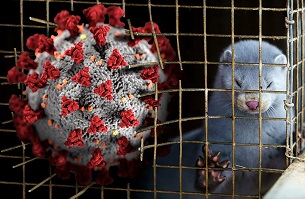COVID-19 News: Worrisome Cryptic SARS-CoV-2 Lineage Identified On Two Mink Farms In Poland That Are Capable Of Infecting Humans!
Thailand Medical News Team Aug 10, 2023 1 year, 8 months, 1 week, 3 days, 1 hour, 42 minutes ago
In a startling development with profound implications for public health, a previously undetected lineage of the SARS-CoV-2 virus, responsible for the COVID-19 pandemic, has been identified on mink farms in Poland. This newly discovered lineage, known as B.1.1.307, has raised concerns due to its potential to infect humans, pointing towards the existence of an unknown animal reservoir capable of sustaining the virus. The emergence of this cryptic lineage underscores the ongoing challenges in managing and understanding the dynamics of the COVID-19 pandemic, particularly at the human-animal interface.

The discovery of this elusive lineage was made during late 2022 and early 2023 when SARS-CoV-2 infections were detected on three mink farms situated in close proximity within Poland. Genomic sequencing of the virus on two of these farms revealed a striking resemblance to a variant identified in human populations from the same region two years prior. Notably, the virus had undergone significant mutations, particularly in the spike protein, suggesting adaptations to the mink host. However, the origin of this virus remains shrouded in mystery, with indications pointing towards a potential animal reservoir that has evaded detection until now.
The broader context of this discovery is framed by the intricate relationship between humans and wildlife, particularly at the interface where zoonotic diseases such as COVID-19 can emerge. The phenomenon of reverse zoonotic spillover, where a pathogen jumps from humans to animals, adds a new layer of complexity to the ongoing battle against the pandemic. The susceptibility of wildlife, especially mink, to SARS-CoV-2 infections has been documented in many studies and
COVID-19 News report, covering various regions in including North America and parts of Europe, raising concerns about the establishment of novel reservoirs for the virus.
The lineage B.1.1.307, detected in mink on Polish farms, exhibited notable genetic differences from the nearest human virus. Over 40 distinct single nucleotide changes were identified, indicating potential adaptation and evolution within the mink population. The virus appears to have undergone a rapid evolution, acquiring mutations that are suggestive of mink adaptation, such as changes in the spike protein at positions 486 and 501. These changes underscore the dynamic nature of the virus and its capacity to undergo genetic shifts when introduced to new hosts.
The detection of this cryptic lineage has prompted a comprehensive investigation into the potential sources of introduction. Detailed site visits and interviews were conducted to ascertain possible routes of transmission. While farm workers and owners' families tested negative for the virus, the occasional presence of wild carnivores, such as martens, and interactions with feral cats and wild bird species were noted. The study also highlighted potential vulnerabilities in the structural barriers meant to prevent wildlife intrusion on the farms.
The implications of this discovery extend beyond the mink farms themselves. The presence of a distinct SARS-CoV-2 lineage in mink raises concerns about the future trajectory of the pandemic. The possibility of reverse spillover from animals to humans adds a layer of complexity to disease management and underscores the importance of rigorous surveillance and monitoring at the human-animal int
erface. While the infected mink did not display signs of disease, the potential for the virus to evolve independently within animal populations and serve as a reservoir for future outbreaks is a pressing concern.
Efforts to control and mitigate the spread of the virus must now encompass a broader scope, including routine surveillance of mink farms and other potential animal hosts. The identification of this cryptic lineage underscores the critical need for proactive surveillance strategies that go beyond reactionary responses to symptomatic outbreaks.
The study also highlights the necessity of collaborative efforts between veterinary and public health authorities to monitor and understand the dynamics of viral transmission at the human-animal interface.
In conclusion, the emergence of a novel SARS-CoV-2 lineage on mink farms in Poland serves as a poignant reminder of the complex interplay between humans, animals, and infectious diseases. This discovery underscores the ongoing challenges posed by the COVID-19 pandemic and the imperative to remain vigilant in monitoring, understanding, and mitigating the transmission of the virus. As the global community continues to grapple with the pandemic's ramifications, the identification of this cryptic lineage offers valuable insights into the virus's evolution and the intricate web of interactions that shape its trajectory.
The study findings were published in the peer reviewed journal: Eurosurveillance.
https://www.eurosurveillance.org/content/10.2807/1560-7917.ES.2023.28.16.2300188
For the latest
COVID-19 News, keep on logging to Thailand Medical News.
